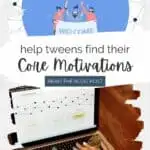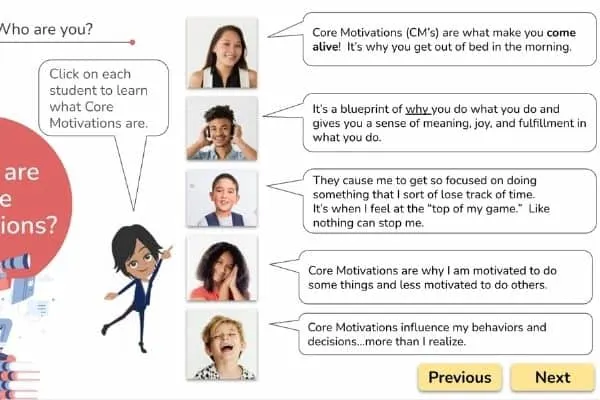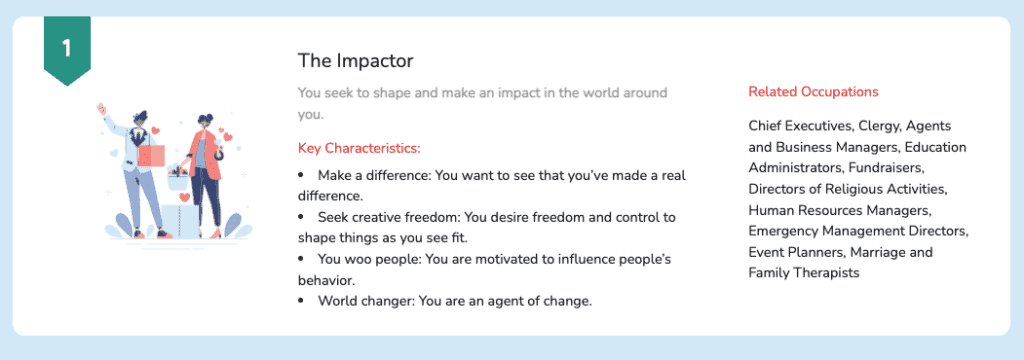Helping kids discover their passions and chart a career path is a chief concern for homeschooling parents. For many of us, providing an enriching environment where kids can pursue their greatest interests is one of the main reasons we homeschool. But figuring out what to do with one’s life is hard enough for adults, let alone kids. Taking a core motivations test can help your students learn more about themselves and what drives them, serving as a starting off point for pursuing future career options.
The core motivations test and curriculum offered by TruSpark are helpful tools for building self-awareness in middle school and high school students and starting conversations about life goals.

I received free access to TruSpark for review purposes and I was compensated for my time. All opinions are my own and I am not required to post a positive review.
Why Motivation Matters in Homeschooling
In the past year, I’ve learned a lot about what motivates my oldest daughter. After nine years of homeschooling–one-and-a-half of which were done in a state of isolation that made homeschooling infinitely less fun–we knew we needed a change. We were no longer communicating well with each other. I was nagging her all the time to get stuff done and she was pushing back against me with all her might.
The joys we’d once experienced in home learning were distant memories and we struggled to get through any of the curricula we’d chosen.
One by one, I started making changes that removed me from the role of teacher, or even invigilator. We moved to a live online math class instead of a self-paced one and worked out a system for science where she got to design projects of her own making instead of completing the worksheets included in the program we used.
The changes helped ease tensions between us, and I started to see some trends.
Meeting deadlines and getting her work done for the sake of getting it done weren’t strong enough motivators for her.
But when she had an outside teacher (i.e. not me), giving her assignments and marking them, she sat up and paid attention. She was extremely motivated to get praise from her teachers and to be at the top of every class she took. When she worked on the science projects that she initiated herself, incorporating her many skills and talents into the process, she thrived much better than she had completing worksheets that would merely be graded and returned to the binder, never to be referred to again.
It quickly became apparent that she had some real felt needs that were not being met. She needed to be around other students and have healthy competition with them. She craved praise from teachers and recognition of her hard work and achievements. She wanted someone to validate that her efforts were indeed excellent.
Knowing all of that, I might have been able to create an environment for her at home and in our homeschooling community that gave her what she needed to excel. But with restrictions in place and so many of our homeschooling activities canceled, it felt impossible.
So, I enrolled her in a public fine arts school in September. More on that in a moment.
What are Core Motivations?
Core motivations help us understand ourselves and why we find some activities more rewarding than others. They are inherent in our personalities, emerge at a young age, and stay with us throughout our lives.
Our core motivations are those factors that drive us to get out of bed in the morning and tackle the tasks ahead of us. They explain why we enjoy certain things but are frustrated by others. When we know what our core motivations are and work with them instead of against them, they give us a sense of meaning, joy, and fulfillment in what we do.
There are nineteen identified core motivations, and everyone possesses some unique combination of these. Here are a few examples of the types of motivation people experience:
- Achiever: You are motivated to give your absolute best as you go above and beyond what’s expected.
- Builder: You are motivated by the process of building and developing things from start to finish.
- Helper: You identify and fulfill needs, requirements, and expectations.
- Impactor: You seek to shape and make an impact in the world around you.
- Teacher: You are motivated to learn something new and show that you can do it.
You can learn more about all nineteen of the core motivations here.
How does the TruSpark Core Motivations Quiz Work?
The TruSpark core motivations assessment gives students a chance to learn more about their core motivations and use that information to make informed decisions about their future plans. Based on over sixty years of research in motivational science and systems for identifying motivated abilities (SIMA), TruSpark is a tween-friendly assessment that takes these big concepts and makes them more accessible.
The TruSpark assessment is grounded in personal narratives. Students are asked to think of two times in their lives where they did something really well and felt good about it. They are then asked a series of questions that helps them get to the core of why they felt good about those experiences. The process unfolds like this:
- Students are asked to describe an experience in a few sentences.
- They are asked to identify what stood out most for them about that experience.
- They are then shown a series of activity cards. Each activity card features one motivating factor, i.e. “I saw what needed to be fixed and fixed it.” They must drag each card into one of two piles to indicate whether the statement was true of their experience or not.
- On the next screen, they are shown only the cards that were true of their experience. This time, they are asked to sort them into another two piles indicating whether this was an awesome part of their story or just an okay part.
- From the awesome pile, they are asked to choose their top five activity cards.
- From these, they must rank the top three most satisfying parts of the story.
- They repeat the whole process again with a second story.
- Finally, they rank the two stories, indicating which one stands out as a more significant event in their life.
- Once they’ve completed both stories and ranked them, TruSpark displayed their results: their top three core motivations with key characteristics and related occupations

From there, students can click on the suggested occupations to learn more about them on a secondary site called My Next Move. Here, they can explore recommended careers and learn about:
- An overview of each job and its responsibilities
- The knowledge, skills, and abilities needed to do the job
- Personality traits required to do well in that position
- Technology that one might use on the job
- Preferred education level
- Job outlook including mean salaries
This assessment is one step in a three-level curriculum that helps students learn about the types of experiences and situations that allow them to be their best, understand themselves on a deeper level, and explore educational and career paths that leverage their core motivations.
In the second and third levels, students learn the importance of having meaningful work, develop the ability to explore different career development tools, explore at least three jobs that fit with their core motivations, and create a character card celebrating their top three motivations.
The Benefits and Limitations of a Core Motivations Assessment
Two of my daughters and I took the TruSpark core motivations assessment as part of this review. We enjoyed reflecting on success stories from our pasts and analyzing why they made an impact on us.
It’s always beneficial to learn more about ourselves and what makes us tick. For teens especially, I think it’s crucial for them to know that the myriad idiosyncrasies that combine to make them who they are do not mean that they are “weird” or “different” or “unknowable”. (Though personally, we embrace terms like weird pretty fiercely in our family!) It helps them to understand that while each of their individual traits is explainable and has value, it’s the way those traits come together that makes them unique and uniquely qualified to live the life they were designed for.
I also appreciate that this quiz has been specifically designed for young teens, who are at a life stage where developing a deeper understanding of their own uniqueness and how it might shape their growth trajectory is so important.
Using the Results of the Assessment
The results indicated my top three motivations are:
- Impactor: You seek to shape and make an impact in the world around you.
- Helper: You identify and fulfill needs, requirements, and expectations.
- Improver: You consistently seek to make things better and enhance them.
These findings are in line with what I know to be true about myself and what I’ve learned from other personality and interests tools such as the Enneagram type test and the Myers Briggs test. At least I’m consistent!
However, I was a little disappointed in the job recommendations provided for these motivations, which included agents and business managers, education administrators, financial advisors, recreational therapists, geographic information scientists, and information security analysts. As an adult with an advanced education and a decade-and-a-half of varied work experience, I am certain that none of these careers would have been a good fit for me.
In fact, I was surprised that the nature of the jobs suggested felt so flat to me. Almost all of the titles were technical or business-oriented and carried with them the suggestion of large, bureaucratic organizations that would drive me crazy.
So I clicked through to My Next Move and started exploring a bit more. Here I was able to take a very quick 60+ question quiz that helped narrow down my interests. I then received a score on six interest markers: realistic, investigative, artistic, social, enterprising, and conventional.
My highest score by far was the artistic interest, followed by smaller showings in the social and enterprising interest categories. After clicking through to see the jobs My Next Move now recommended for me, I was able to breathe a sigh of relief. All of the things I actually love doing (and am motivated to do) were now on the list
My takeaway from this experience is that we need to consider both interests and motivations as we help our children move forward into career exploration. As the TruSpark curriculum indicates, a person can be truly fulfilled and satisfied in any number of careers, as long as they’re able to express their core motivations in those roles. For example, a person who is motivated by teaching doesn’t necessarily have to be a classroom teacher, but there should be some aspect of their career that allows their gift of teaching to shine through.
My recommendation, then, would be to use the core motivations assessment and curriculum to understand your child’s motivations and develop a list of potential career options, and then follow it up with an interests assessment on the My Next Move site. This will provide a second list of career options. Work through the two lists with your child and see if there is any overlap. Ask them which options sound enticing to them and which they would like to learn more about.
Then use this as a jumping-off point for exploring different career options together.
How We’re Using This Information in Our Homeschool
So you may be wondering what happened to my daughter after we sent her to a public fine arts school.
A few positive things emerged. She connected really well with most of her teachers and enjoyed learning new skills from them. She learned that she’s extremely values-driven and is not afraid to stand up to anyone–even her teachers–if she believes an injustice has occurred or been overlooked. She also learned that she enjoys being part of a team effort, but only when the whole team is motivated to work hard and produce excellent results. Her patience for slackards is slim indeed.
Nonetheless, she decided to switch back to homeschooling after one semester. Interestingly, I can see a link between some of her core motivations and why school didn’t work out well for her. She is a visionary and an explorer. She needs the space to dream up new ideas and pursue them anywhere and everywhere. She is inquisitive, creative, and adventurous and likes to do things her own way and in her own time.
And homeschooling is the best way for her to express those motivations right now.
But as we go forward, it’s essential that we’re thinking about and planning for her future, exploring skills and interests, and seeing where her motivations get a chance to shine. As these traits and interests strengthen, we will look for opportunities for her to put them to a test in a work setting and see if her motivation holds up.
For better or worse, she’s the kind of person whose efforts are deeply tied to her motivation level, and figuring out what motivates her is often half the battle to helping her get things accomplished.
And for that, the core motivation assessment was a useful tool that helped us fill in another piece of the puzzle. Check it out today, and enter below for your chance to win the TruSpark curriculum and two assessments.

Sophie Agbonkhese is a writer, homeschooling mother of four, and a recovering overachiever (who occasionally relapses). She is the founder of My Cup Runs Over, a site dedicated to helping busy women simplify and enrich their lives. When she’s not writing or debugging websites, Sophie spends her time reading, dancing, bullet journaling, reading, gardening, listening to audiobooks, and striving fruitlessly to have a clean house for at least five minutes.




